‘Be very fast, and invisible’
LEGENDARY music photographer Jill Furmanovsky joined November’s branch meeting online after being made a NUJ life member. She was warmly introduced by fellow music journalist Phil Sutcliffe, who told us "She wins awards left, right and centre. She is hugely well regarded internationally in what she does... but, being an old music journo, I can report she's a great person to work with, whether it be at home or in foreign parts when we’re all strangers working as a team. So, Jules you’re simply the best."
Jill thanked Phil for his "most enchanting introduction," saying that she and Phil had had some wonderful rock and roll adventures. "And for those who don't know, Phil is responsible for the group The Police, featuring Sting - being introduced to each other. And I was not quite there when he did it but was shortly afterwards when it all came together so Phil's a bit of a legend in our business as well."
Jill’s breakthrough shot in the music press was of Roger Daltrey from The Who. In 1972 as an 18-year-old student with only four days of training as a photographer she got a job at the famous gig venue the Rainbow Theatre in Finsbury Park, which is now a mega-church. She photographed The Who doing their rock opera Tommy and gave her Roger Daltrey image to Melody Maker.
"You brought your picture in on a Monday or Tuesday and the paper came out on a Thursday." She described coming out of college and walking past the news-stand seeing her very first cover for Melody Maker was the Roger Daltrey picture and being absolutely thrilled. It was groundbreaking for the music press to feature the work of a woman - as she told us, at the time the Melody Maker was a kind of a boys’ club and the only women working there were the secretaries.
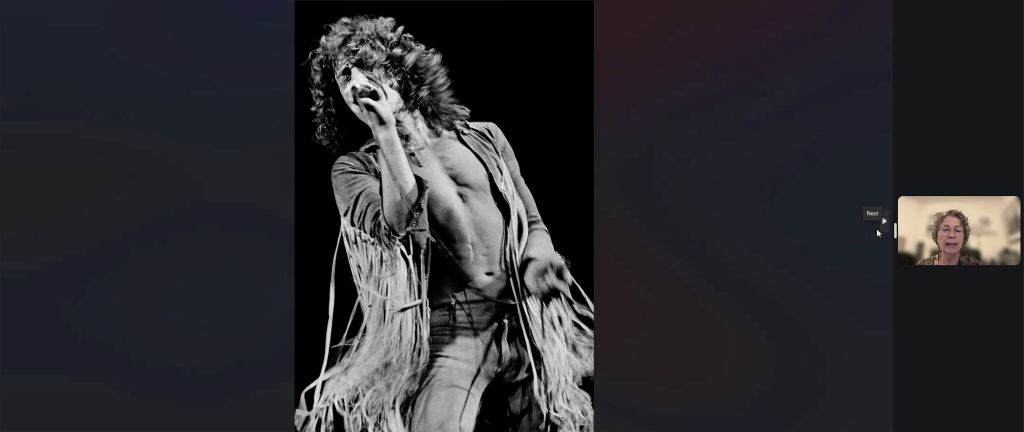
Roger Daltrey
Jill then showed us a poignant image, taken on New Year’s Eve 1977 backstage at the Rainbow, of Sid Vicious of the Sex Pistols, Sid’s girlfriend Nancy Spungen and the Ramones. Jill explained "The bottle of champagne that Nancy's holding was because it was about to be midnight, and we were moving from 1977 into 1978."
Jill included this shot because she said, nobody was aware of the camera at all. Everybody was so engrossed in what they were doing that I just sort of slipped in the doorway, snatched a couple of pictures and left before anybody ever saw any of it. She said how this become a kind of a technique of hers, to be very fast and as invisible as possible.
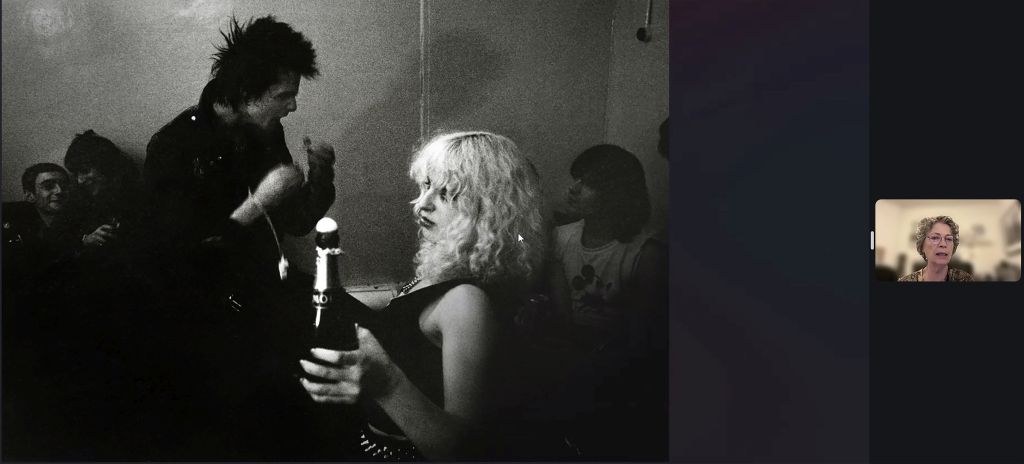
Sid Vicious, Nancy Spungen and the Ramones
Jill then showed us her image of "the beloved Bob Marley in a hotel room in Gloucester Road, 1978. Marley was dovetailing with the punks; Reggae was very popular with the punk generation and Bob Marley wrote a song called Punky Reggae Party mentioning the Clash, the Jam and the Damned. When I photographed him, he had had a lot of problems in Jamaica, and so, he was in London recording for Island Records."
She told us that she loved this picture "because you can just about see that he's got some smoke coming out of his mouth, which came from his spliff because as a Rastafarian, he had to smoke his ganja. But I decided not to show what he was smoking, and not show the spliff because I was worried that he might be arrested because at that time, you could very easily be arrested for having marijuana."

Bob Marley
She showed us a portrait of the Cure taken in February 1979 outside the Melody Maker offices in the freezing cold. "But this is the Cure looking like schoolboys, which I guess they were at the time... Whether they came and were doing an interview and then I took them out to do the pictures I don't know, but they do all look very cold. Robert [Smith] is, I think, looking sweet and very schoolboy. That did, of course, change and possibly the next frame will show his change here. He went from that schoolboy look to this dishevelled looking 80s icon which he's still using now 30 years later. He has aged most wonderfully, gothically and is still producing superb music. He's very much in the news now because his latest album just went to number one, He's a man with great integrity, and tremendous talent. But he was once a young schoolboy having his picture taken outside a building for Melody Maker."

The Cure, 1979
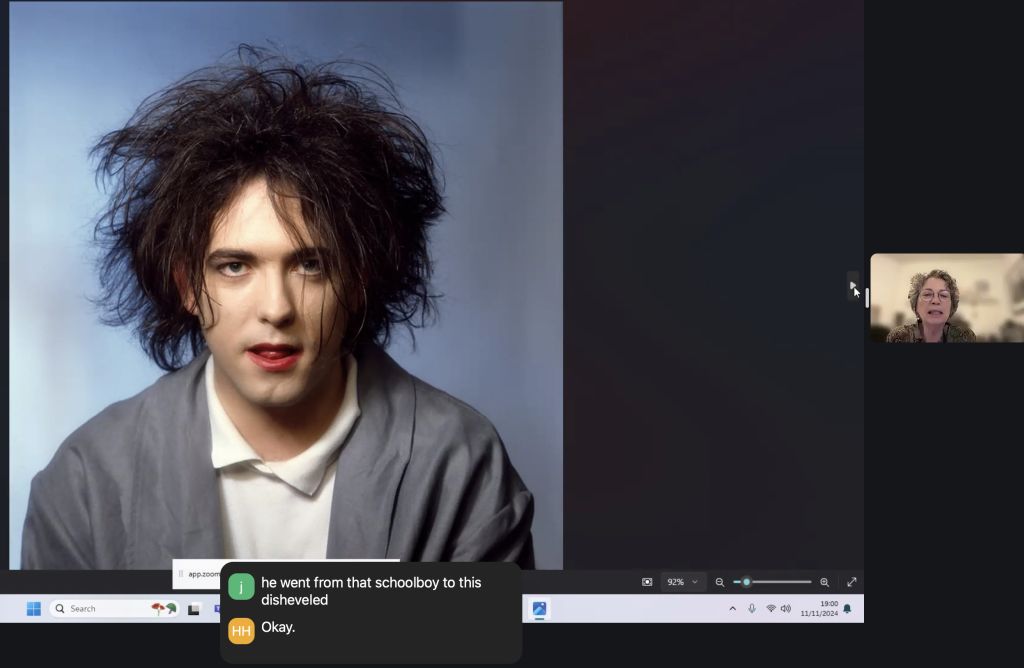
Robert Smith
This is Stevie Wonder [below]. "There are two pictures: the portrait of Stevie Wonder and the two portraits of him in his glasses [which] were shot on film. The image in the glasses was shot at the Rainbow Theatre around 1973 and the second one, which is his head, was shot in 1991 when he was back in the UK. It was the digital revolution that enabled me to use Photoshop to drop into his glasses the younger version of himself and him looking up… making the pictures reflective of his long period as a musician."
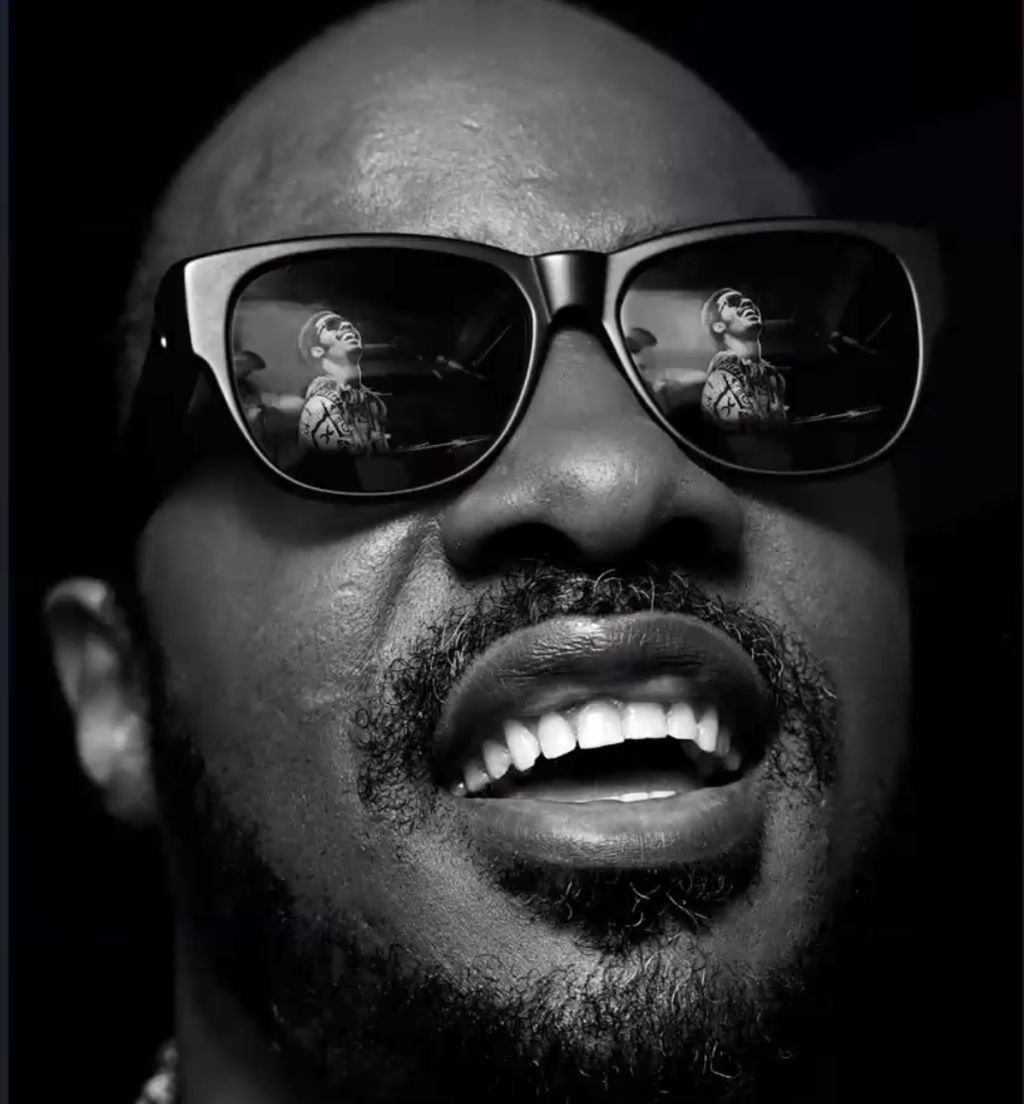
Stevie Wonder
"I started photographing Madness in 1979 - and I think 1980 for the Face magazine was my first shot of Madness leaning. It's not that I told them to lean - it was just that Madness are brilliant at arranging themselves in formations and the 'naughty train' which they perfected when they were just teenagers is a kind of classic pose that no band has ever matched. For the last 40 years or so, we've done these leaning shots every few years and I'm now up to six of them. This is number five: it was taken on New Year's Eve when they were doing one of those celebrations with the fireworks. I managed to persuade them to go out in the street and lean in front of Westminster Abbey, against a phone box, before rushing back in and going straight on stage and it was one of the most nerve-wracking shoots I've ever done because it was live TV."
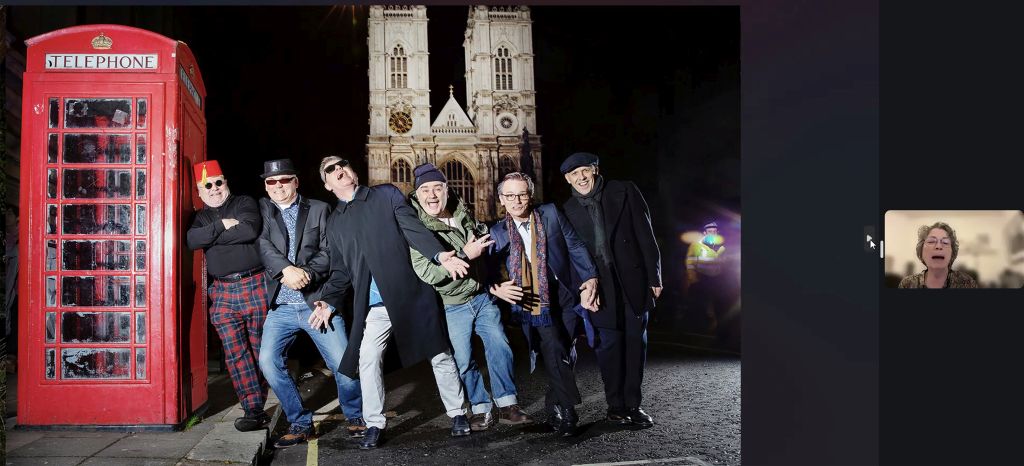
Madness
"I'm known for my pictures of Oasis. I worked with them a great deal over their career from 1994 right up to their demise in 2009. I'm hoping they might let me in when they re- form later next year.
"I love this picture of Noel and Liam. If you kind of zoom your eyes in they're touching in one, two, three, and four places, but not actually connecting and that kind of summed up their relationship so close and yet so apart. To me this is my kind of Diane Arbus moment, Diane Arbus was very good at photographing family members."
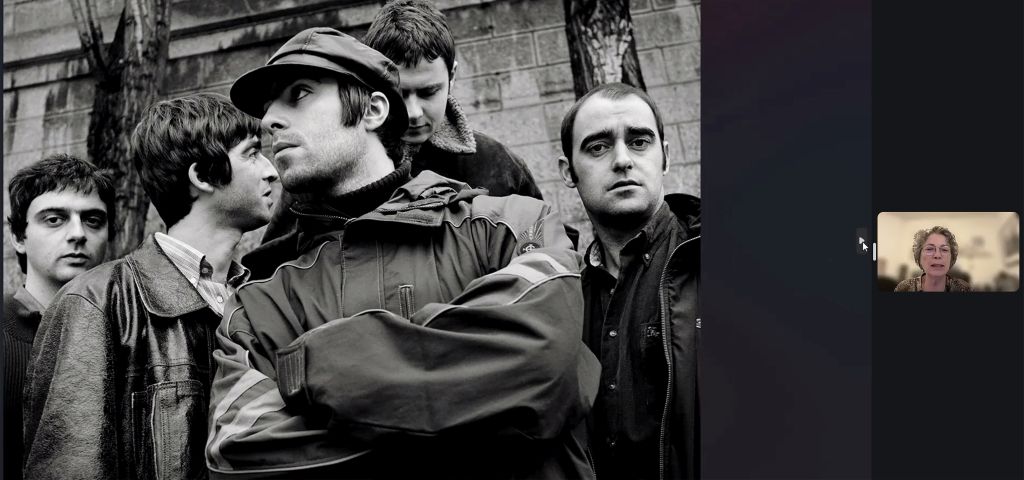
Oasis
"This, the final one, is a picture of Liam Gallagher and Bono behind him. This shot was done live in San Francisco. When Noel used to sing Don't Look Back in Anger, Liam used to leave the stage and sit on the drum riser, or a monitor and he was sitting out on the edge of the stage beautifully lit. I wandered over to photograph him sitting there watching Noel singing and suddenly this figure loomed in the back, and it was Bono. Oasis was supporting U2, and I hadn't seen Bono, and I thought who the hell is that? But I managed to switch focus very quickly on this apparition behind Liam. To me, this is a kind of father and son image, this mad young boy and his dad. Bono at that time took on a kind of a dad role for the Gallagher brothers. So that's a little peek into my archive."
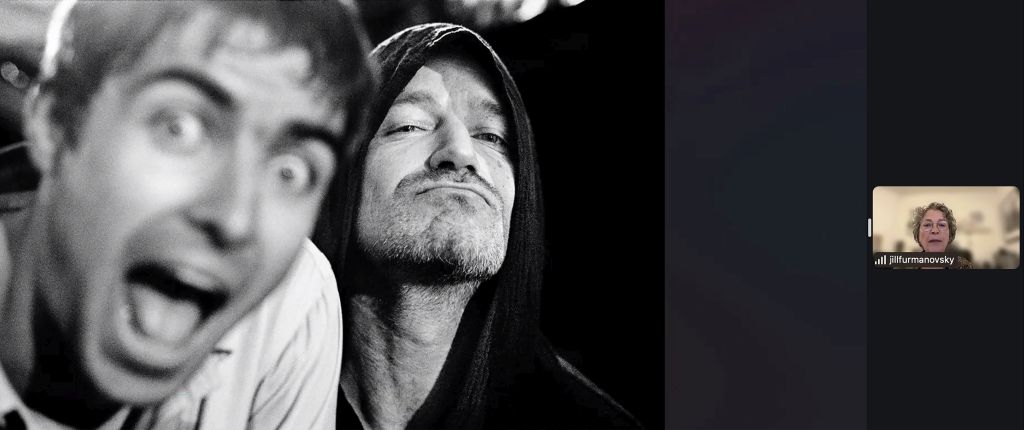
Liam Gallagher and Bono
On being the only woman at the Melody Maker
"I'd already had a lot of pictures published by Melody Maker, but they never gave me a credit, but they would credit other photographers. I plucked up the courage to see the editor Ray Coleman and asked him. ‘Is there any chance I could have a credit for my pictures like the others’?
"He looked over his glasses in a head masterly sort of way and said: ‘You will get one when you deserve one and then I never did get one, even though I'd had that cover It wasn’t until he left and somebody else came in as editor that I got credited in the Melody Maker’.
"That's what I mean by the kind of thing that you had to put up with… I was too young to challenge somebody as important as an editor.
"But I never gave up. I always thought let my pictures do the talking. Annie Leibovitz was important because she was doing conceptual photography and, she had status at the Rolling Stone so I remember thinking you don't have to just take a live picture you could do something more than that. I wasn't really influenced by music photographers, although Dezo Hoffman was an influence because I was a Beatles fan and member of the Beatles’ fan club. I think I was more your kind of Cartier Bresson, Richard Avedon. Don McCullen, who used to teach at my college, used to come and give lectures. I saw myself as a frontline photojournalist. My college thesis was about the exploitation of distress and was about how I didn't feel I could handle being a war photographer, but there was some part of me that enjoyed being on the front line and so those were the kind of photographers that I admired the most."
Questions
Q: Have you ever photographed David Bowie?
"I did photograph David Bowie at the Rainbow Theatre, but how about this as a bit of bullying I had a pass saying I was the official photographer. No sooner had I done a couple of songs than a man jumped off the stage, a security man, and said to me, ‘you shouldn't be photographing David Bowie’. I said, I should because I've got this pass, which I showed to him. He said, no, we've got our own photographers. He then opened the back of my camera and pulled the film out. It was assault. What could I do? I was assaulted by a security man. Well, he didn't assault me personally, but he took my camera and ripped the film out of the back. Afterwards, I went backstage to see the manager of David Bowie, who was at the time a bit of a wide boy with a girl on each arm. I said to him, this is what happened to me. And you know what he did? He thrust a bottle of champagne at me, and said, here, you have this.
"I said, no, thank you. And after that, I assumed it was David Bowie who had issued this dictate, but it wasn't. Actually, it was another photographer, Mick Rock, a very famous rock and roll photographer, who had decided that it would be a good idea if he was the only photographer to do Bowie and therefore persuaded the management to say only, he should do David Bowie. And some of the other photographers also had problems doing Bowie at the time. But eventually Bowie kicked the manager out and then he was very good with photographers. But I never photographed him, and I regret it because I think he was a great guy."
Sally Gethin: "Thanks very much Jill. I freelanced for Melody Maker about a decade after you started with them and sadly, they were still very much a boy’s club.
"In fact, I’d go so far as to say openly sexist and because I was a young student at university, I was also very impressionable. I also had a similar experience to you, I would submit my article I think the newspaper came out on a Wednesday then, and I would go to the news stand nearest University College where I was a student and obviously, I don't think I ever got the cover story, but inside it was a massive thrill. Coming back to the issue of females working I'm going to talk about Melody Maker by the time I got involved, I think the only woman was Helen Fitzgerald who was supposed to be the daughter of the Irish prime minister, but the rest of the female staff were administrative. Although I tried to freelance for other music outlets, I came across this wall of misogyny, and in the end, I gave up with my freelance music journalism because I found it such a struggle. I'm glad that you have made such an amazing career out of it and that you are not jaundiced in your view of it - it's very heartening to hear that.
Jill Furmanovsky "Oh, thank you. I do think it has been a battle, but it was a calling more than anything else. I just felt I had to carry on and I don't know why.
Sally Gethin: "Perhaps that explains, your commitment and dedication. I think for me, it was a foray into the world of journalism. I was 19 when I got my first review published in there and I didn't really know where I was heading. So perhaps I was more easily deterred but like I said, that's very heartening. Your photos are incredible, they really are."
Q: If you were on a desert island, and you had to pick one photograph to save what would it be
Jill Furmanovsky: "It’s got to be Charlie Watts, of course. I've got this famous picture of Charlie Watts. And you'd want to share your desert island with Charlie Watts, wouldn't you (The drummer of the Rolling Stones for those young people who don't know who he is). He was the solid beat of rock and roll - so Charlie Watts would be the one I'd take and also, I won the Jane Bown Award for my Charlie Watts portrait, and she was a hero of mine from the press - the wonderful Jane Bown of the Observer.
"Thank you for my life membership of the NUJ. That's my real reward. I'm going to be framing that certificate."
![[Freelance]](../gif/fl3H.png)